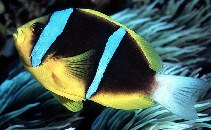| Family: |
Pomacentridae (Damselfishes), subfamily: Pomacentrinae |
| Max. size: |
17 cm TL (male/unsexed) |
| Environment: |
reef-associated; marine; depth range 0 - 40 m, non-migratory |
| Distribution: |
Pacific Ocean: Queensland, Australia and New Guinea to the Marshall and Tuamoto islands. |
| Diagnosis: |
Dorsal spines (total): 10-11; Dorsal soft rays (total): 15-17; Anal spines: 2-2; Anal soft rays: 13-14. Description: Body short and deep; the head small. Generally yellow in the body edges, yellow-brown to dark brown in the middle sides, with two white vertical stripes, the first behind the eye and the second before the anus. Fins yellow. Juveniles dull orange (Ref. 1602). Body depth 1.8-1.9 in SL (Ref. 90102). |
| Biology: |
Adults inhabit passages and outer reef slopes. Known to occur at 25°C. Feed chiefly on planktonic copepods, algae, echiuroid and sipunculoid worms, and pelagic tunicates. Oviparous, distinct pairing during breeding (Ref. 205). Eggs are demersal and adhere to the substrate (Ref. 205). Males guard and aerate the eggs (Ref. 205). Associated with the anemones: Entacmaea quadricolor, Heteractis aurora, Heteractis crispa, Heteractis magnifica, Stichodactyla haddoni, and Stichodactyla mertensii (Ref. 5911). Minimum depth reported taken from Ref. 128797. |
| IUCN Red List Status: |
Least Concern (LC); Date assessed: 01 August 2021 Ref. (130435)
|
| Threat to humans: |
harmless |
Source and more info: www.fishbase.org. For personal, classroom, and other internal use only. Not for publication.
